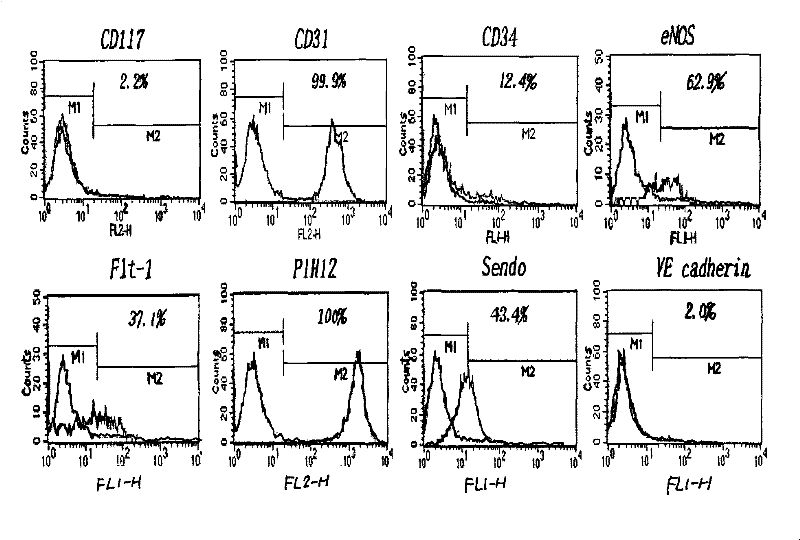Method for largely expanding late endothelial progenitor cells from peripheral blood
A technology of endothelial progenitor cells and peripheral blood, which is applied in the biological field, can solve the problems of fewer late endothelial progenitor cell colonies, affecting clinical efficacy, and hindering the prospect of clinical use.
- Summary
- Abstract
- Description
- Claims
- Application Information
AI Technical Summary
Problems solved by technology
Method used
Image
Examples
preparation example Construction
[0031] (2) Preparation of trophoblast cells in a culture dish: 1×10 late endothelial progenitor cells or HUVECs (umbilical cord endothelial cells) obtained from previous culture 3 Cells were planted in 1% collagen-coated 6-well plates, with EGM2 as the culture medium, at 37°C, 5% CO 2 Cultivate in the incubator for 6 hours, and after the cells adhere to the wall, they are irradiated with a dose of 10Gy to inhibit their growth.
[0032] (3) In vitro culture of mononuclear cells: the isolated mononuclear cells were planted into the prepared 6-well plate, with EGM2 as the culture medium, at 37 ° C, 5% CO 2 Cultured in an incubator, changing the medium every other day.
[0033] The above-mentioned in vitro culture medium is a uniformly sold culture medium on the market; mononuclear cells are divided into 5×10 7 Cells were seeded into 6-well plates coated with 1% collagen; the coating concentration of collagen was 5-10ul / cm 2 ; Trophoblast radiation dose 10Gy.
[0034] (4) Iden...
Embodiment 1
[0041] 1. Isolation of human peripheral blood mononuclear cells: Take 100ml of human venous anticoagulant blood, dilute it with PBS balanced salt solution 1:1, slowly spread 32ml of the diluted solution onto the 18ml of Ficoll separation solution along the tube wall, and use 2000r / m, centrifuged for 30 minutes, after density gradient centrifugation, suck out the white ring-shaped cloud layer, then wash twice with PBS balanced salt solution at 1000r / m, 10 minutes, and finally resuspend the cells with culture medium, and count with placenta blue cell.
[0042] 2. Preparation of trophoblast cells in a culture dish: 1×10 late endothelial progenitor cells or HUVECs obtained from previous culture 3 Cells were planted in 1% collagen-coated 6-well plates, with EGM2 as the culture medium, at 37°C, 5% CO 2 Cultivate in the incubator for 6 hours, and after the cells adhere to the wall, they are irradiated with a dose of 10Gy to inhibit their growth.
[0043] 3. In vitro culture of mon...
PUM
 Login to View More
Login to View More Abstract
Description
Claims
Application Information
 Login to View More
Login to View More - R&D
- Intellectual Property
- Life Sciences
- Materials
- Tech Scout
- Unparalleled Data Quality
- Higher Quality Content
- 60% Fewer Hallucinations
Browse by: Latest US Patents, China's latest patents, Technical Efficacy Thesaurus, Application Domain, Technology Topic, Popular Technical Reports.
© 2025 PatSnap. All rights reserved.Legal|Privacy policy|Modern Slavery Act Transparency Statement|Sitemap|About US| Contact US: help@patsnap.com



